Performance
A £1,000 notebook is certain to be quick, but exactly how far can you go with an Intel Core i5 processor and dedicated AMD graphics? Will the latter enable on-the-go gaming, or will it result in little more than rapid battery depletion?
Providing stiff competition in our benchmarks is the 15.6in Acer Aspire 5754DG which offers NVIDIA graphics and 3D Blu-ray support at the same price point. To see if the Envy warrants the premium price tag, we've also included performance numbers for an £800 Lenovo ThinkPad Edge 15 and two 13.3in systems fetching £650 at retail.
Here's a detailed look at the key specifications of our comparison notebooks, as well as a brief rundown of the benchmarks we use.
| Comparison systems | |||||
|---|---|---|---|---|---|
| Laptop | Acer Timeline 3810T | ASUS U35JC | HP Envy 14-1050EA | Lenovo ThinkPad Edge 15 | Acer Aspire 5745DG |
| Processor | Intel Core 2 Duo SU9400 (1.40GHz, 3MB L2 cache, dual-core) | Intel Core i3 370M (2.4GHz, 3MB L3 cache, dual-core) | Intel Core i5 450M (2.4GHz, 3MB L3 cache, dual-core) | Intel Core i5 430M (2.26GHz, 3MB L3 cache, dual-core) | Intel Core i5 450M (2.4GHz, 3MB L3 cache, dual-core) |
| Memory | 2GB DDR3 | 4GB DDR3 | 4GB DDR3 | 4GB DDR3 | 4GB DDR3 |
| Graphics | Intel GMA 4500MHD | Intel HD Graphics + NVIDIA GeForce 310M 1GB | Intel HD Graphics + AMD Mobility Radeon HD 5650 1GB | Intel HD Graphics | NVIDIA GeForce GT 425M 1GB |
| Graphics driver | Intel 7.15.10.1666 | Intel 8.15.10.2182 + NVIDIA Verde 258.96 | Intel 8.15.10.2182 + AMD Catalyst 10.9 | Intel 8.15.10.2057 | NVIDIA Verde 259.12 |
| Display | 13.3in - 1,366x768 | 13.3in - 1,366x768 | 14.5in - 1,366x768 | 15.6in - 1,366x768 | 15.6in - 1,366x768 |
| Battery | 6 cell, 56Whr | 8 cell, 84Whr | 8 cell, 59Whr | 6 cell, 48Whr | 12 cell, 99Whr |
| Weight | 1,645g (including battery) | 1,816g (including battery) | 2,589g (including battery) | 2,476g (including battery) | 2,839g (including battery) |
| Wireless | Intel WiFi 5100 (802.11bgn) and Bluetooth | Atheros AR9285 (802.11bgn) and Bluetooth | Broadcom 43224AG (802.11bgn) and Bluetooth | Intel WiFi Link 1000 (802.11bgn) and Bluetooth | Broadcom WLAN (802.11bgn) and Bluetooth |
| Disk drive | Hitachi 500GB HDD, 5,400RPM, 8MB cache | Seagate Momentus 320GB HDD, 5,400RPM, 8MB cache | Seagate Momentus 500GB HDD, 7,200RPM, 16MB cache | Seagate Momentus 320GB HDD, 5,400RPM, 8MB cache | Hitachi Travelstar 500GB HDD, 5,400RPM, 8MB cache |
| Optical drive | None | None | DVD-RW | DVD-RW | Blu-ray/DVD RW combo |
| Operating System | Microsoft Windows 7 Home Premium, 32-bit | Microsoft Windows 7 Home Premium, 64-bit | Microsoft Windows 7 Home Premium, 64-bit | Microsoft Windows 7 Professional, 64-bit | Microsoft Windows 7 Home Premium, 64-bit |
| Approx. price as configured | £650 | £650 | £1,000 | £800 | £1,000 |
| Benchmarks | |||||
| Geekbench 2.1.6 | A cross-platform benchmark used to measure memory and processor performance. Run using high-performance mode. | ||||
| Cinebench 11.5 | Using Cinebench's multi-CPU render, this cross-platform benchmark stresses as many cores as possible. Run using high-performance mode. | ||||
| 3DMark06 | A PC benchmark used to test the DirectX 9 performance of a system's graphics card. Run using high-performance mode. | ||||
| Power consumption | Using balanced power settings, we record mains power draw whilst playing back a 720p movie trailer. | ||||
| Battery test | In order to measure battery life, we run the notebook on balanced power settings and loop a 720p movie trailer, measuring the time taken to hibernate. | ||||
CPU and GPU performance
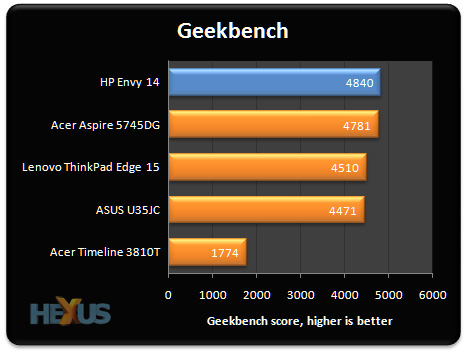
The HP Envy 14's 2.4GHz Intel Core i5 450M processor is quick, and when coupled with 4GB of DDR3 memory it provides excellent notebook performance.
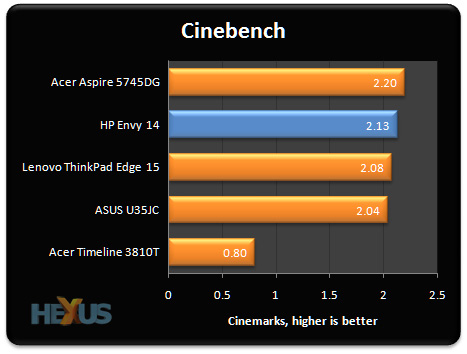
Cinebench confirms the CPU potential, and in real-world terms the Envy 14 is more than capable. Windows 7 is highly responsive, and we had no trouble editing high-res images using Photoshop.
The use of a 7,200rpm hard disk certainly helps maintain a quick user experience, but we'd love to see HP offer an SSD option as standard.
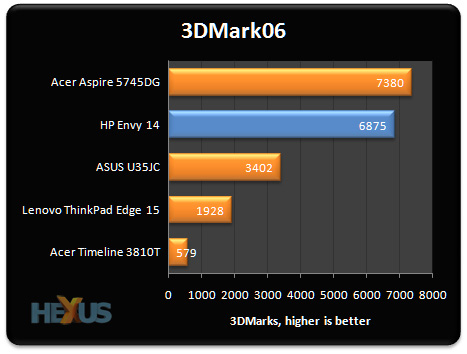
Ensuring impressive all-round system performance, the Envy 14's AMD Mobility Radeon HD 5650 graphics card scores an impressive 6,875 3DMarks - putting it ahead of the NVIDIA GeForce GT 335M found in Dell's gaming-orientated Alienware M11x, and narrowly behind the GeForce GT 425M used in Acer's Aspire 5754DG.
Playing back HD video is of course a breeze, but the HP Envy 14 is also capable of playing some of the latest 3D games - though, you will have to make sacrifices in image quality. To give you an idea, we recorded an average frame rate of 25.17 in Just Cause 2 at the system's native resolution with medium texture quality and 2xAA and 8xAF. To get a smooth 40.16 frames per second we had to drop to low quality, 0xAA and 2xAF. Similarly, Mafia II provided a playable 35.5 frames per second at low-quality settings, whilst Civilisation 5 returned a stuttering 20fps.
With 400 shaders, a 40nm core clocked at 450MHz and a 1GB frame buffer, the Mobility Radeon HD 5650 GPU is certainly capable. It's just a shame that switching between the Radeon and Intel HD graphics isn't as seamless as NVIDIA's Optimus, but will that have an impact on battery life?
Power consumption and battery life
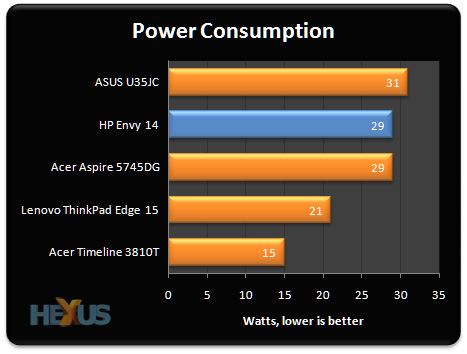
With the Envy 14 plugged in and configured to utilise the Radeon GPU, it draws 29W of power whilst playing back a 720p HD video. About average for a system with a discrete GPU.
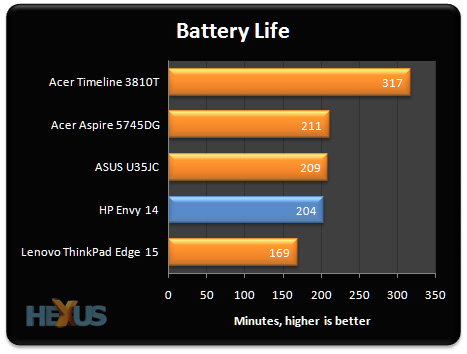
Battery life, whilst not exceptional, is also about average for a near-15in machine with a powerful CPU and dedicated graphics.
In our video rundown benchmark - which entails looping a 720p video until system hibernation - the Envy 14 managed to keep going for three hours and 24 minutes. Using the system for basic web browsing, meanwhile, returned a reasonable run time of four hours and 33 minutes. Not bad, but if longevity is high on your list of requirements, you're going to want to invest in the optional battery slice at the expense of weight and size.









